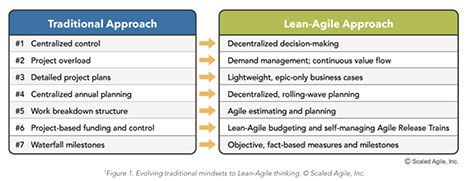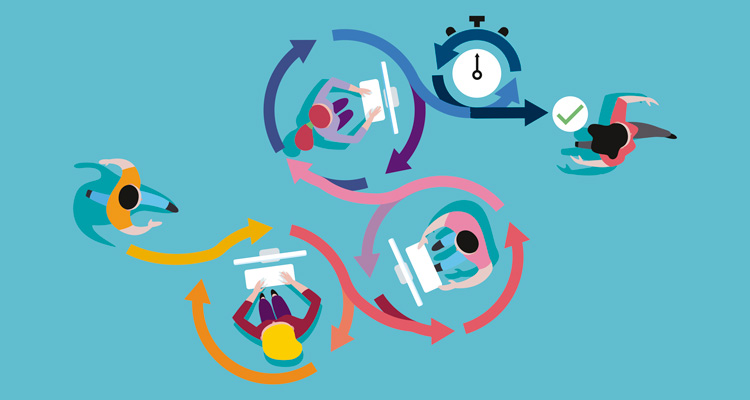
Stephen Hawking once said, “Intelligence is the ability to change.” With the blistering pace of technological, economic, and sociopolitical changes, it’s clear that enterprises have to change—not just in the products and services they provide, or the platforms through which they provide them—but also in the way they plan, fund, and execute work. And lean portfolio management allows you to get there.
Traditional portfolio management practices leave gaping holes for disruptors to, well, disrupt. In order for modern enterprises to compete, they have to be able to evolve their portfolio management practices to boost agility while leveraging the stability and infrastructure that gives them market advantage.
Lean portfolio management helps organizations re-engineer their planning and funding practices to align more closely with desired business outcomes, giving them a fighting chance of matching or outpacing the agility of their competitors.
In this series of posts, we’ll be diving deeper into the specific strategies and tools Lean enterprises can use to truly practice Lean portfolio management, including:
- Strategy and investment funding
- Agile portfolio operations
- Lean governance
In this post, we’ll focus on defining Lean and Lean portfolio management, understanding why traditional portfolio management practices need to evolve, and examining the advantages of Lean portfolio management practices.
Whether you’re an executive looking to make the drastic changes needed to compete in the digital economy, or a manager who’s been tasked with increasing agility at the project level, this series is for you.
Traditional Planning Practices and Why They Must Evolve
Typically, enterprises encourage extensive planning on the front-end to drive predictable results on the back-end. Predictability, of course, is a worthy goal for any organization, especially those with VIP stakeholders expecting specific results. Put another way, if you’re responsible for driving a cruise ship, at the very least, you need to be able to take it from point A to point B.
So, business units present their ideas to the PMO in an annual planning meeting. IT provides cost and time estimates and executives prioritize funding based on perceived value delivery in 12-18 months or longer.
Then, teams get to work. Teams are incentivized to stay on track towards delivering the agreed upon plan and are measured according to how well they are able to stay on budget and on time. Once again, predictability is the name of the game—can we deliver the thing we said we would deliver 12 months ago—as opposed to delivering customer value—can we deliver the thing our customers want right now and in the future?
If the organization were truly operating in a vacuum, this approach might work. And compared to the constantly changing, ever-evolving landscape organizations now find themselves in, perhaps a few decades ago you could argue that some organizations had the luxury of operating in a vacuum: They knew more or less what their customers wanted, and they had few competitors with the resources to threaten their ability to deliver.
But what if the market demands change? What if new information contradicts the information that was used to develop the plan? If you imagine a traditional planning approach as a waterfall, you realize that once the plan is set in motion, it will literally require defying gravity to make a change.
In a world where companies like Uber or Lyft can go from concept to industry-creating IPO in a matter of a few years, enterprises simply cannot afford to let gravity do the work. In today’s world, predictability is still important, but it cannot be the measure of progress. Customer value—and your organization’s ability to deliver it quickly must become the yardstick against which you measure your growth.
Enter: Lean
But how? By becoming Lean. If you’re reading this blog, you’re likely familiar with at least the fundamental ideas of Lean. Depending on where you first heard of Lean, you may associate it with cost cutting, streamlining, or relentless efficiency (the more traditional definition, rooted in manufacturing). Or, you may prescribe to a more human-centric, purer form of Lean, which emphasizes continuous improvement, respect for people, and a laser focus on delivering customer value (this is the Lean we practice and preach).
If you’re new to Lean or would like a refresher, we recommend reading this eBook (Getting Started with Lean) to deepen your understanding of what it is that makes up a modern Lean practice.
What is Lean Portfolio Management?
Lean portfolio management applies these Lean principles to the planning and funding of corporate strategic initiatives. It encourages the application of Lean principles at every level of the organization.
Traditional approaches inhibit the flow of value and innovation in the enterprise. They were simply not designed for a global, digital economy. What exactly makes the Lean approach better suited for the world today?
Key Elements of Lean Portfolio Management

Decentralized Decision Making
Traditional portfolio management practices were designed in organizations with hierarchical, top-down, command-and-control systems of decision making. In these types of organizations, big decisions are left to the ‘higher ups’, resulting in a painfully slow, gated process that actively discourages innovation or agility. And yet, in order to remain competitive, enterprises have to be able to create innovative solutions to current problems quickly.
Lean-Agile organizations accomplish this through a more decentralized system of decision making, empowering those closest to the work with the autonomy to make decisions. This not only increases speed and efficiency, it also gives employees the space to innovate and adapt based on real, accurate data.
Continuous Value Flow
In traditional enterprises, planning and funding decisions are made in long cycles, meaning that business units have to plan, execute, and deliver multiple projects on the same timelines—leading to project overload.
Lean portfolio management instead encourages demand management, meaning that work is planned, executed, and delivered as demand dictates it (with respect to capacity) in a continuous flow. At the work delivery level, this reduces the wasteful context switching that comes from having too much work in progress at any given time. For individuals, this can drastically improve job satisfaction by reducing the cognitive weight of balancing multiple large initiatives at once.
Lightweight Business Cases
Imagine that you’re tasked with planning your child’s fifth birthday party. She just turned three. You have to submit a detailed plan for decorations, the flavor of the cake, the types of balloons she’ll want, where the snack table will be, who will be invited, etc. within the next week. If you don’t turn it in on time, she will not have a fifth birthday party.
Obviously, it doesn’t make sense to spend time trying to figure all of this out now; there are simply too many unknowns to be able to say with any degree of certainty that your party will hit the mark. And yet, this is the position we put our teams in when we ask for detailed project plans for work that will be done 12-18 months in the future. At best, our plans are made based on highly speculative and lagging ROI predictions. And yet this is how traditional organizations determine funding for projects.
Lean portfolio management relies on lightweight, epic-only business cases that use the data available to develop a loose, living framework for how a business goal will be achieved. As more data becomes available, the details are filled in, and a (still mutable) plan is developed. This means teams waste less time developing incredibly detailed, yet unlikely-to-be-accurate plans, and more time focused on delivering value to the customer based on actual needs.
Decentralized, Rolling-Wave Planning
Centralized annual planning cycles result in rigid plans that leave little room for new information or innovation. Lean portfolio management instead encourages decentralized planning cycles, so that planning can occur throughout the year, as needed, instead of on a rigid schedule.
This might take the form of Program Increment (or PI) Planning, which is a timebox during which an Agile Release Train (ART) will deliver incremental value in the form of working software. Instead of conducting this planning across the entire organization, the ART (a team made of 5-12 teams) will practice PI Planning on their own schedule—with each PI usually lasting 8-12 weeks. The most common pattern for a PI is four development iterations, followed by one Innovation and Planning (IP) Iteration. Since Agile Release Trains conduct this planning, execution, and delivery together and independently of the rest of the organization, they are able to test, learn, and deliver faster than if they were operating as part of a centralized planning cycle.
Agile Estimating and Planning
Traditional portfolio management methods rely largely on work breakdown structure, which is a deliverable-oriented way of structuring projects. Since teams are measured based on their ability to deliver what are often document-driven deliverables, they aren’t directly incentivized to innovate. In fact, it’s the opposite: They’re incentivized to stick to the plan at all costs, in order to earn gold stars upon completion of each task.
These ‘gold stars’ do not necessarily equate to customer value—in fact, they often don’t, since as we’ve discussed, requirements for projects are often gathered far in advance of when the work is being completed. Success, then, becomes a measure of how well teams are able to present deliverables in spite of market shifts—not how well they’re able to incorporate those shifts into their plans and deliver an actually desirable product.
Lean-Agile Budgeting and Self-Managing ARTs (Agile Release Trains)
Typically, once projects have been approved, temporary, cross-functional teams are created to deliver the work. One person might be assigned to several projects, and therefore working with several teams at a time. Since these teams aren’t working side-by-side, day-to-day, they usually schedule recurring status meetings to stay in sync. Many people end up spending most of their days like this: switching from meeting to meeting with little time to digest, implement, or inform others about new information.
This method of moving people to the work like this as opposed to letting the work come to the people is incredibly inefficient, for several reasons. First is the one mentioned above—it makes it so that employees spend most of their time chasing information, instead of delivering value.
The second is that it makes it difficult to establish consistency in methods, tools, communication methods, etc. If the NBA scrambled its rosters before every game, the quality of play would suffer greatly simply because players wouldn’t know each other, and so they wouldn’t know how to best play together to maximize all of their strengths.
If you consider Tuckman’s stages of group development, which says that all teams must go through periods of forming, storming, and norming before they can perform, you realize that most project teams likely never even reach the performing stage before they are disbanded to work on the next project—with a whole new team.
The root of this problem is the way projects are funded. Project-based funding and cost accounting create an environment ripe for friction, inefficiency, and bureaucracy.
Instead, Lean organizations use Lean-Agile budgeting and self-managing Agile Release Trains to encourage the development of high-performing, cross-functional teams. Usually made of 5-12 teams, ARTs are long-lived, self-organizing teams of teams that plan, commit, and execute work together. This, coupled with a Lean-Agile budgeting approach (in which budget is allocated to the full value stream, as opposed to individual projects), allows Lean organizations to foster growth and innovation while reducing waste at every level of delivery.
Objective, Fact-Based Measures and Milestones
Traditional methods rely on waterfall milestones, usually in the form of document-based deliverables, as a measure of progress. Teams and the individuals who lead them are evaluated based on the team’s ability to deliver certain deliverables by certain dates.
The problem with this system is that whether or not a team delivered a specific document by a specific time doesn’t necessarily measure that team’s ability to deliver customer value. If executives call teams to ‘innovate’ and ‘think outside the box’, but teams are evaluated by their ability to stay within the box, it’s no surprise that many enterprises today are finding themselves with a seriously weak innovative muscle.
So, there you have it. The key elements of Lean portfolio management that you need to understand and how they can benefit the way your organization accomplishes work. With Lean portfolio management, you can begin to re-engineer your organization’s planning and funding practices so that they align more closely with desired business outcomes. Only then will you be able to keep up with the pace of change and truly challenge your competition.
Continue reading the next installments in this series on Lean portfolio management, where we will cover:
- Part 2: Lean budgets and investment funding
- Part 3: Lean Portfolio Management Operations: An Agile Approach
Be sure you check out the whitepaper, “Lean Portfolio Management for the Enterprise,” which delves into greater detail on what we discussed above.






